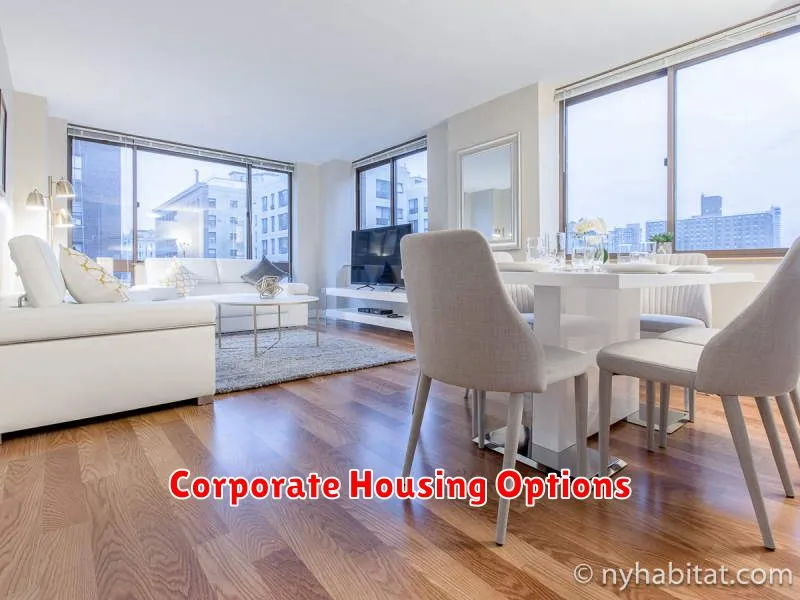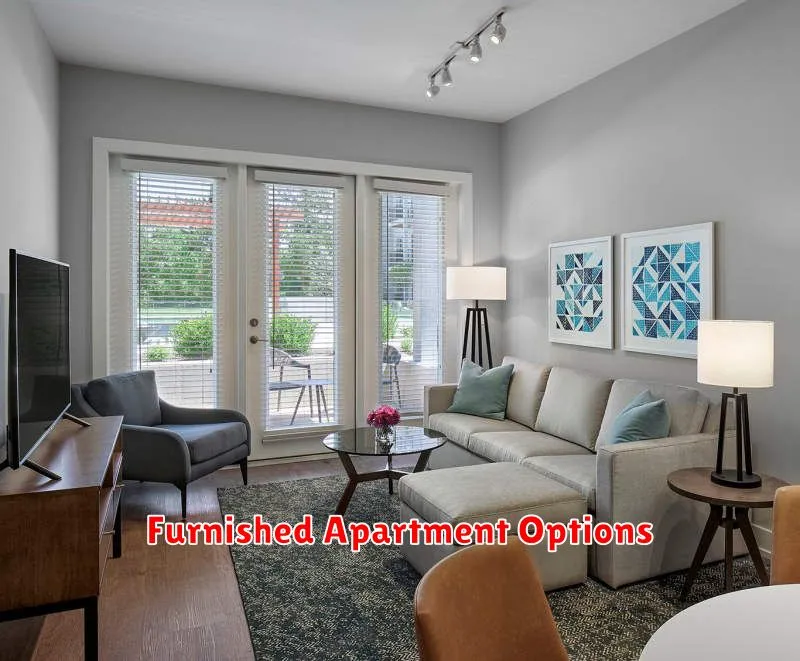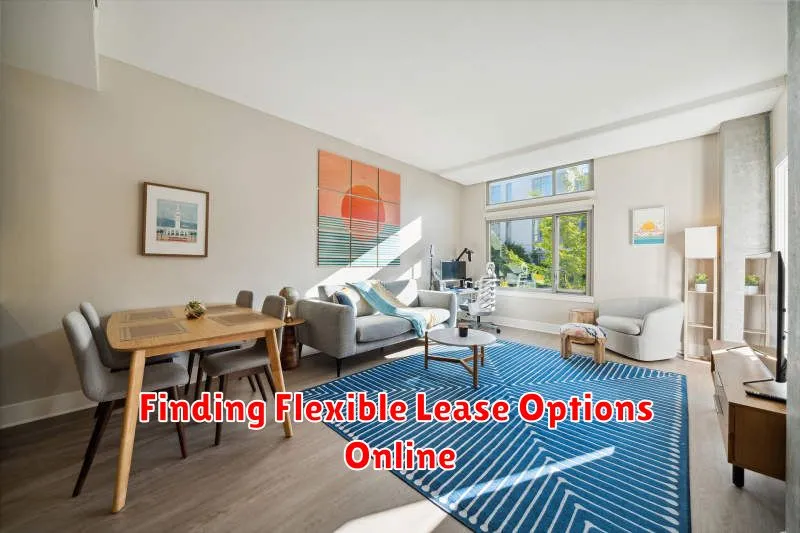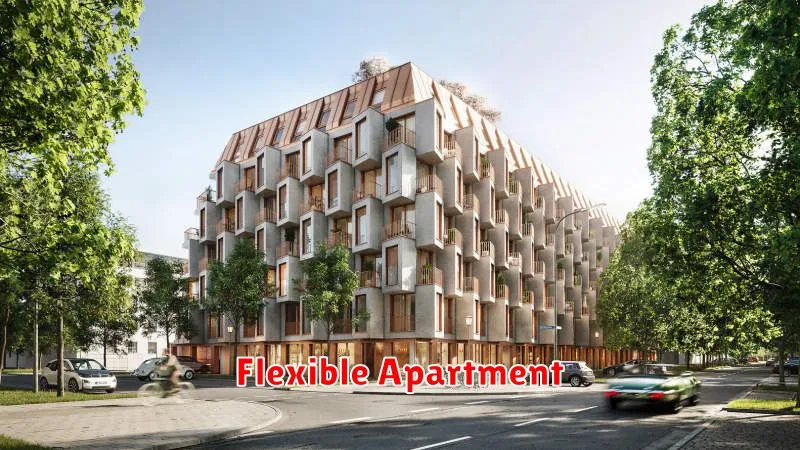Are you tired of traditional lease agreements that lock you into long-term commitments? Finding a place to live shouldn’t feel like a trap! Fortunately, there are numerous apartment leasing options catering to flexible renters like yourself. Whether you’re a digital nomad seeking temporary housing or a student looking for a short-term arrangement, these options offer the freedom and flexibility you crave. Read on to discover a world of possibilities beyond the traditional lease!
Understanding Your Rental Needs
Before you start looking at different apartment leasing options, it’s essential to understand your needs. Consider these questions:
- What is your budget?
- How long do you plan to stay in the apartment?
- What are your must-have amenities?
- What is your desired location?
- Do you have any pets?
- What is your preferred lease term?
Once you’ve answered these questions, you’ll have a better idea of what to look for in an apartment. This will help you narrow down your search and find the perfect place to call home.
Short-Term Leases
For renters who need flexibility and are not looking for a long-term commitment, short-term leases are an excellent option. These leases are typically for periods of 6 months or less, offering renters the freedom to move without the burden of a lengthy contract.
Short-term leases are particularly advantageous for individuals or families who are in transitional periods, such as those relocating for work, completing a renovation, or waiting for a permanent residence to become available. They also provide a great opportunity for trying out a new neighborhood or living arrangement before committing to a longer lease.
While short-term leases offer flexibility, it’s important to note that they may come with higher monthly rent costs compared to traditional long-term leases. Landlords may charge a premium for the convenience of shorter terms. However, this is often offset by the freedom and convenience they offer, making them a worthwhile choice for those who prioritize flexibility.
Before signing a short-term lease, carefully review the terms and conditions, including the renewal process and any associated fees. Understanding these details will help you make an informed decision and avoid any potential surprises.
Month-to-Month Agreements
Month-to-month agreements are a popular choice for renters who desire flexibility. Unlike traditional leases, which often bind tenants for a set period like 12 months, month-to-month agreements provide tenants with the freedom to move out with only a 30-day notice. This flexibility is particularly beneficial for those who are uncertain about their long-term plans, such as recent graduates, traveling professionals, or individuals transitioning between homes.
However, it’s important to note that month-to-month agreements might come with some downsides. Landlords often charge higher rent for these agreements to account for the inherent unpredictability. Additionally, landlords have the right to increase rent with a reasonable notice period, usually 30 days. Furthermore, month-to-month agreements may be less appealing to landlords who prefer stable, long-term tenants.
If you’re considering a month-to-month agreement, it’s crucial to thoroughly read and understand the terms of the agreement. Pay close attention to the notice period, rent escalation clauses, and any other conditions stipulated by the landlord.
Subleasing Options
Subleasing is a great option for renters who need flexibility, whether it’s for a short-term stay or a change in circumstances. It essentially involves renting out your current apartment to someone else while you continue to be responsible for the lease with the landlord. You will need to obtain permission from your landlord to sublease, and the terms of your lease agreement will likely dictate the process and any restrictions.
Here are some things to keep in mind when considering subleasing:
- Finding a Subtenant: You can advertise your apartment on online platforms, through your network, or use a subleasing service. Be sure to thoroughly vet potential subtenants to ensure their financial stability and reliability.
- Subleasing Agreement: Create a written subleasing agreement that outlines the terms of the sublease, including rent amount, deposit, duration of the sublease, and responsibilities of both parties.
- Financial Responsibilities: You remain responsible for the original lease agreement, so ensure your subtenant pays rent on time and covers any damages to the apartment.
- Landlord’s Approval: Always secure written approval from your landlord before subleasing. They may have specific requirements or restrictions that need to be met.
Subleasing can be a convenient and cost-effective way to manage your lease when you need flexibility. However, it is important to understand the legal and financial implications before proceeding.
Negotiating Lease Flexibility
For renters who crave flexibility, negotiating a flexible lease is a game-changer. A flexible lease grants you the freedom to adjust your living situation based on your changing needs. While standard leases typically lock you into a fixed term, negotiation can unlock possibilities like shorter terms, early termination clauses, or even month-to-month agreements. This can be particularly valuable if you’re uncertain about your future plans or anticipate a potential move.
Here are some key strategies for negotiating lease flexibility:
- Be upfront about your needs. Communicate your desire for a flexible lease to your landlord or property manager from the outset. Explain the reasons behind your need for flexibility, be it career changes, travel plans, or uncertainty about your long-term stay. Transparency fosters trust and allows for a constructive dialogue.
- Offer concessions. Landlords are more likely to consider flexible terms if you offer something in return. This could include a slightly higher rent, a longer initial lease term, or a security deposit. Be creative and explore options that benefit both parties.
- Research market trends. Understand the rental market in your area. If rental demand is high, you might have more leverage to negotiate favorable terms. Knowing the average lease lengths and typical rent prices will empower you during negotiations.
- Prepare a strong proposal. Outline your desired flexible lease terms in a clear and concise proposal. Specify the lease length, any termination clauses, and any potential rent adjustments. A well-structured proposal demonstrates your seriousness and professionalism.
- Negotiate in good faith. Be respectful and understanding of the landlord’s perspective. While you may have specific needs, remember that landlords also have business concerns. Approach the negotiation with a willingness to compromise and find a mutually beneficial solution.
- Get everything in writing. Once you reach an agreement, ensure it’s documented in the lease agreement. A written record protects both parties and avoids any future misunderstandings.
Negotiating lease flexibility requires preparation and communication. By clearly outlining your needs, offering concessions, and engaging in good faith, you can potentially secure a lease that aligns with your dynamic lifestyle.
Lease Break Clauses
Lease break clauses, also known as break clauses or early termination clauses, are provisions in a lease agreement that allow a renter to break the lease before its expiration date under specific circumstances. These clauses can be incredibly valuable for renters who anticipate needing flexibility in their living arrangements. While not common in all leases, understanding how they work is essential for renters who need to remain adaptable.
Types of Lease Break Clauses
- For a Specific Reason: Some clauses allow termination only for certain predefined reasons, such as job relocation, military deployment, or unforeseen medical situations.
- For Any Reason: More flexible clauses allow termination for any reason with a predefined notice period and potential financial penalties.
Benefits of Lease Break Clauses
For flexible renters, lease break clauses offer peace of mind, as they provide a legal pathway to exit a lease when life circumstances change. However, it’s crucial to understand the limitations and potential costs associated with invoking these clauses. Renters should always carefully review the terms and conditions of a lease agreement before signing, paying close attention to any lease break clauses and associated fees.
Negotiating a Lease Break Clause
While landlords may not always be willing to include a lease break clause, it’s worth negotiating for one. Renters can demonstrate their financial stability and commitment to the lease, and potentially propose a reasonable financial penalty or compromise to secure the inclusion of a break clause.
Alternatives to Lease Break Clauses
If a lease break clause isn’t available, renters might explore other options, such as subleasing or assigning the lease to another tenant. However, these alternatives may also have limitations and require landlord approval.
Early Termination Options
If you need to break your lease early, you may be able to do so without incurring significant penalties. However, it’s important to understand your rights and responsibilities under your lease agreement.
The first step is to review your lease agreement carefully to determine if there are any clauses that allow for early termination.
Here are some common reasons for early termination:
- Job relocation: If you have to move for a job, you may be able to terminate your lease early. You may need to provide documentation from your employer to support your claim.
- Military deployment: If you are called to active military duty, you may be able to terminate your lease early. You will need to provide documentation from the military.
- Domestic violence: If you are a victim of domestic violence, you may be able to terminate your lease early.
- Uninhabitable conditions: If your apartment becomes uninhabitable due to a fire, flood, or other disaster, you may be able to terminate your lease early.
If you meet the requirements for early termination, you may be able to do so without paying any penalties. However, you may still be responsible for paying rent for the remaining term of the lease. You may also be responsible for any costs associated with finding a new tenant for your apartment.
If you are considering breaking your lease early, it is important to speak to your landlord or property manager. They can advise you on your options and help you understand your responsibilities.
Rent-to-Own Agreements
Rent-to-own agreements, sometimes called lease-purchase agreements, allow tenants to live in an apartment while simultaneously working towards owning it. These agreements typically involve a down payment and monthly payments that go toward the purchase price. The tenant will have the option to purchase the apartment at the end of the lease term, often at a predetermined price.
Benefits of Rent-to-Own:
- Potential to build equity: A portion of your monthly payments goes toward building equity in the property.
- Time to prepare: Rent-to-own agreements give you time to save for a down payment and improve your credit score, making it easier to secure a mortgage when you’re ready to buy.
- Security of knowing future ownership: Knowing that you have the option to buy the property in the future provides a sense of stability and security.
Drawbacks of Rent-to-Own:
- Potential for higher costs: Rent-to-own agreements often come with a premium, so you may pay more than you would if you were just renting.
- Lack of flexibility: You are committed to the property for the entire lease term. If you need to move before the end of the lease, you could lose your down payment.
- Risk of defaulting: If you fail to make your monthly payments or meet other terms of the agreement, you could lose your down payment and be evicted.
Before entering a rent-to-own agreement, carefully consider your financial situation and weigh the potential benefits and drawbacks. Make sure to read the terms of the agreement carefully, and understand all your obligations.
Corporate Housing Options

For those who need a temporary housing solution, corporate housing offers a unique and often advantageous alternative to traditional apartment rentals. Corporate housing is designed specifically for individuals and companies needing short-term stays, typically for periods of 30 days or more.
These furnished apartments are typically located in convenient urban areas and come equipped with amenities such as utilities, internet access, and sometimes even laundry facilities.
Here are some key benefits of corporate housing:
- Flexibility: Lease terms are usually more flexible compared to traditional leases, allowing for shorter stays or the ability to adjust your stay as needed.
- Convenience: They are often located in convenient, central locations near workplaces, restaurants, and public transportation.
- All-Inclusive: Corporate housing options frequently include utilities, internet, and basic amenities like linens and kitchenware.
- Professional Management: Corporate housing providers typically offer dedicated customer service and property management, ensuring a smooth experience.
Furnished Apartment Options

Furnished apartments are a great option for those who are looking for a temporary or short-term housing solution. They can also be a good choice for people who are relocating or traveling for work. Furnished apartments come with all the essential furniture and appliances you need to move in right away, so you don’t have to worry about buying or transporting your own. This can save you time and money, and it can also be a great way to avoid the hassle of unpacking and setting up a new place.
There are many different types of furnished apartments available, from studios to multi-bedroom units. You can also find furnished apartments in a variety of locations, from urban centers to suburban areas. If you are looking for a furnished apartment, it is important to consider your budget, your needs, and your lifestyle. Some factors to consider when choosing a furnished apartment include:
- Rental cost: Furnished apartments are typically more expensive than unfurnished apartments, but they can be more affordable in the long run because you don’t have to purchase furniture.
- Lease terms: Furnished apartments often have shorter lease terms than unfurnished apartments, making them ideal for those who are only looking for a temporary place to stay.
- Amenities: Furnished apartments may offer amenities such as laundry facilities, parking, and fitness centers.
- Location: Furnished apartments are available in a variety of locations, so you can choose one that is convenient for you.
If you are considering renting a furnished apartment, it is important to do your research and compare different options. It is also a good idea to read reviews from other tenants before making a decision. By taking the time to carefully consider your needs and options, you can find a furnished apartment that is a perfect fit for you.
Considering Location and Amenities

When choosing an apartment, location and amenities are crucial factors for renters seeking flexibility. Location plays a significant role in your daily life, influencing your commute, access to amenities, and overall lifestyle. Consider factors such as proximity to work, schools, public transportation, and entertainment options. If you value a vibrant social scene, living in a bustling city center might be ideal. Conversely, if you prefer a quieter environment, a suburban location with parks and green spaces may be more appealing.
Amenities enhance your living experience and can cater to your specific needs and preferences. In-building amenities, such as fitness centers, swimming pools, and laundry facilities, provide convenience and add value. Community amenities, like parks, bike paths, and community gardens, offer opportunities for recreation and socializing. Consider amenities that align with your lifestyle and hobbies, such as a dog park if you have a pet or a business center if you work from home.
Ultimately, the best location and amenities will vary depending on your individual needs and preferences. By carefully evaluating these factors, you can choose an apartment that provides the flexibility and comfort you desire.
Finding Flexible Lease Options Online

Finding flexible lease options online can be a great way to find an apartment that fits your unique needs. Many websites and platforms cater specifically to renters looking for shorter lease terms, month-to-month options, or other flexible arrangements. Here are some tips for finding the best flexible lease options online:
Use specialized search filters: Many apartment search websites, like Apartments.com or Zillow, allow you to filter your search results based on lease length. You can specify that you’re looking for a lease term shorter than 12 months, or even just a month-to-month option. This can help narrow down your results and save you time.
Check out dedicated flexible lease websites: There are websites like Furnished Finder and Domu that specifically cater to flexible living arrangements. These websites often offer a range of lease options, including short-term rentals, sublets, and co-living spaces. You can also find furnished apartments, which can be ideal for short-term stays.
Contact landlords directly: Even if an apartment listing doesn’t explicitly mention flexible lease options, it’s worth contacting the landlord directly to see if they’re open to negotiation. Some landlords might be willing to offer a shorter lease term or a month-to-month agreement, especially if they have difficulty finding long-term tenants.
Be prepared to pay a premium: Flexible lease options often come with a higher price tag than traditional leases. This is because landlords have to cover the risk of tenants leaving early or changing their mind. Be prepared to pay a higher rent, a security deposit, or other fees when you sign a flexible lease.
Read the lease agreement carefully: Before signing any lease agreement, make sure you understand the terms and conditions. Pay attention to the renewal process, the notice period for termination, and any fees associated with early termination. This will help you avoid any surprises down the road.

